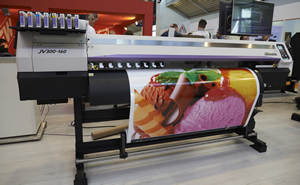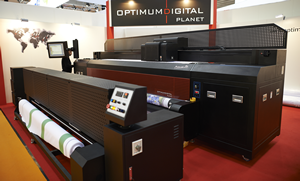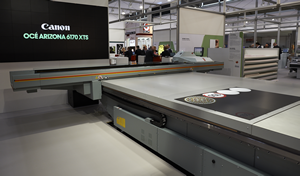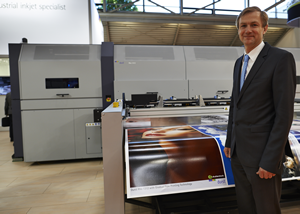Nessan Cleary takes you through the key printer developments of Fespa Digital 2014.
Fespa Digital 2014 certainly delivered in terms of product launches, especially when it came to new printers, a large number of which were shown in Europe for the first time. That said, many were really incremental upgrades to existing models, developments largely to address the demand for a better cost/productivity balance.
In terms of mid-volume production printers, several new machines shown at Fespa, including Canon’s new Arizona 6100 series, and the Fujifilm Acuity F (see panel).
Screen’s Truepress Jet W3200UV, which we tested last month, is also aimed at this mid-volume market. For Fespa, Screen announced a new HS version, which has an extra row of printheads, taking the maximum throughput up from the 85m2/hr of the standard model to 150 m2/hr. Better still, customers can upgrade the standard edition to the faster spec.
SwissQprint launched a new version of its Nyala flatbed printer. The Nyala2 gains the new Konica Minolta 1024i printheads giving it a production speed of 206 m2/hr - up from 140m2/hr - as well as a bigger bed at 3.2 x 2m, yet with the same footprint as the earlier machine. It has all the same options, including a roll-feeder and tandem production, whereby it can print to a board on one half of the bed, while a second one is loaded or unloaded on the other half.
Durst also launched a new High Speed version of its P10 UV hybrid. Because Durst reassembles other people’s printheads to make its own arrays, it’s managed to double the number of nozzles without taking up any more space. Thus the P10 HS has a maximum print speed of 400m2/hrwith the same 1000dpi resolution. It also gains LED Pin curing, which is used to fix the inks before the conventional curing stage to cope with the faster speed.
(PIC G)Durst also introduced a new Rho 1300 series of flatbeds, aimed at the high production end of the market, but which marks an interesting development. These machines use what Durst calls Gradual Flow Printing, which prints a 250 x 125cm image with a print array that covers the full width. It still needs a couple of passes to make a complete image but sales manager Michael Lackner concedes that the next step would be to print an image with a single pass, which could happen as quickly as next year. If Durst can achieve this without pushing the cost up too much it would significantly shake up wide-format printing, much as high speed single pass inkjet printers have in other sectors such as labels and book printing. As it is, this system delivers a very smooth image, building up the entire image in layers rather than narrow swathes.
Entry-level UV-curable
At the other end of the spectrum, there were a couple of new printers aimed at the entry-level flatbed market that offer reasonable image quality and productivity for a relatively small outlay. Thus Mimaki showed off its new compact flatbed, the JFX200-2513, priced at around £60,000. Despite it’s small size it has a 2.4 x 1.2m bed that is suitable for 8 × 4 boards. It uses Ricoh Gen5 printheads and there’s a choice between tough and flexible inks.
Roland showed off its new UV flatbed, the VersaUV LEJ-640F, which is essentially the print engine from the LEJ-640 hybrid attached to a fixed bed with a print area of 1600 x 2500mm wide. It will take media up to 150mm high, which is significantly more than the normal 50mm and which Roland hopes will help sell it into the industrial market as much as the graphics sector. Besides CMYK it also takes white and transparent inks and can create impressive textures and embossing effects.
Mutoh showed the VJ-1626UH, a 165cm wide hybrid LED UV. It can run two sets of CMYK inks for higher speed, or CMYK plus white and a clear varnish. Maximum resolution is 1440dpi and the fastest print speed is 33m2/hr.
Roll-fed competition
The bun fight between the latex and solvent printers continues apace with a number of new machines shown. Mimaki launched the

new JV300 eco solvent printer, available in 1.3m and 1.6m widths. There’s a choice of four, six or eight colour channels and it takes both SS21 eco-solvent inks and SB53 water-based sublimation inks for printing to polyester materials.
Fujifilm launched the Vybrant F1600, a 1.6m roll-to-roll device capable of producing up to 18m2/hr. Fujifilm claims to be using its own patented Fuze inks but it’s a rebadged Mimaki SUV, with the inks containing UV-curable elements in a solvent carrier. This hybrid ink type is more expensive to run than solvent, but cheaper than UV and solves the issue of having to wait for the prints to out-gas before finishing the job.
Not to be outdone, HP brought along its recently-launched trio of Latex 300 printers, which use the third generation latex inks that cure at a lower temperature than previously and so should work with a wider range of media. HP has also improved the heating elements, so that these printers now reach their curing temperature within less than two minutes, considerably better than having to wait around five minutes or so to use the printer, which ought to give the sort of productivity that you would otherwise expect from a solvent printer.
Textile printing
There were a number of new textile printers shown, most of which were aimed at industrial markets, for which in this instance read as larger POS users and those producing exhibitions, garments and home furnishings applications. Hollanders showed off a 2.5m wide version of its modular Colorbooster printer, which offers industrial printing at lower cost. There’s also a Carpet Edition for producing floor coverings.
Durst introduced a faster Rhotex HS, a 3.3m wide printer that can run at 300m2/hr and should produce around 500,000m2 per year. It uses water-based disperse dye inks, with eight colours, which are said to be suitable for up to two years outdoor use.

Turkish company Optimum Digital Planet showed a 3.2m wide Picasso-Tex textile printer that uses 16 1024 Konica Minolta heads giving it a 2880dpi resolution. Itcan reach up to 210 m2/hr.
Of course, the printers are only part of the equation and next month we’ll look at what Fespa Digital threw up in terms of consumables developments.
Canon branches out
Potentially one of the most significant announcements was that of Canon’s new Arizona 6100 series of UV-curable flatbeds. This machine is a completely new platform and Canon will undoubtedly use it as a base to develop further printers. For now there are two models: the 6160 XTS is a six colour machine, having CMYK plus light cyan and lightmagenta; the 6170 XTS uses seven colours, having an extra channel with white ink. However, there is space in the machine for an eighth channel, which could in the future be used for an additional white channel, a varnish or even for adding extra colour sets.
Pierre-Olivier Esteban, European marketing director for digital graphics for Canon says that the Arizonas have around a third of the
 European market for the sector they currently compete in so this has the potential to really shake up the mid-volume space. He estimates that the market size in Europe for this type of printer is around 300 machines, adding: “Our ambition is to come with a high quality at the price where the market is today.” Regional pricing is yet to be confirmed but indications are that it will come in at the 300,000 – 350,000 Euro mark. The first installations are planned for September.
European market for the sector they currently compete in so this has the potential to really shake up the mid-volume space. He estimates that the market size in Europe for this type of printer is around 300 machines, adding: “Our ambition is to come with a high quality at the price where the market is today.” Regional pricing is yet to be confirmed but indications are that it will come in at the 300,000 – 350,000 Euro mark. The first installations are planned for September.
Fujifilm also announced an Acuity F version at the same time, explaining why it decided against the Inca Digital Avoset prototype that it showed at Fespa last year.


